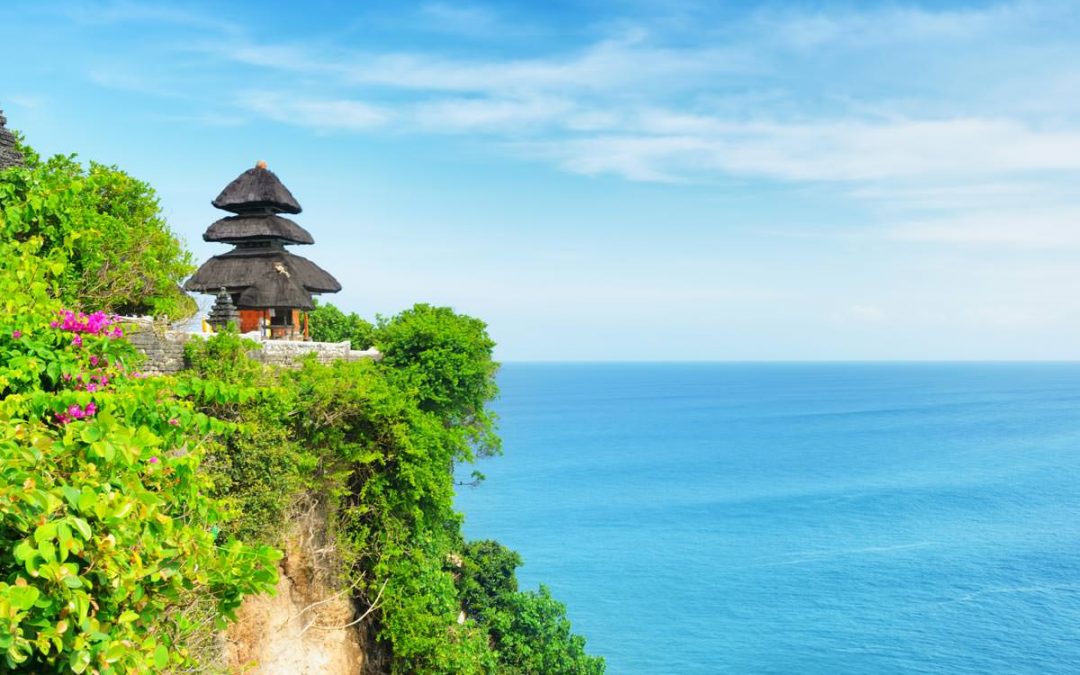Uluwatu Temple located on the very steep valley on the west of Pecatu Village, in the district of Kuta, Badung Regency, about 30 km from Denpasar. It can be reached by any cars, the road are paved but rather steep.
Uluwatu Temple perches at the south-western tip of peninsula, where sheer cliffs drop precipitously into the clear blue sea. Uluwatu Temple hangs right over the edge! You enter it through an unusual arched gateway flanked by statues of Ganesha. Inside, the walls of coral bricks are covered with intricate carving of Bali’s mythological menageries. But the real attractions the in the location – for a good angle, especially at sunset, walk around the cliff to the left (south) of the temple.
Watch out for the local monkeys, which for some reason like to snatch spectacles and sunglasses, as well as handbags, hats and anything else they can get. Uluwatu Temple is one of the several important temples to the spirits of the sea to be found along the southern coast of Bali. Way back in the 11th century the Javanese priest Empu Kuturan first establish a temple here. Uluwatu Temple was added to by Nirartha, another Javanese priest who is known for seafront temples, like Tanah Lot, Rambut siwi and Pura sakenan. Nirartha retreated to Uluwatu for his final days, when he attained moksa, freedom from earthly desires.
Mythology:
There is a story about Hindu priest from Java called “Dang Hyang Nirartha” or “Pedanda Sakti Wawu Rauh”, full of mystical episodes since his arrival until his disappearance in Bali. One of Hindu teaching is the same as other religion that is concerning the world after death or the “here after world ” This world is contrasted into two polarization such as Eden garden and hell. For that devotee, a promise of all goodness and happiness are there which is called “Sorga” In the tradition of Hindu in Bali it is said that the “Sorga” is undeceived by words, and unduplicated with picture. Where truth is an absolute, and body is embraced into it, so it only exist “enlighten “.
But one can not enter the Sorga with worldly body except their holy spirit when he/she during the life had completed duties and behaved as indicated by religious teaching. The other way one can reach Sorga by the way called “Moksa”. It is not quiet clear what is actually meant by the word “Moksa”. Many assumptions arose. One thought it is a body sublimation, that one who has reach his stage of Moksa disappeared in the world without living his/her physical body. This stage can only be reached with a severe body control on senses while developing knowledge by meditation or hermitage.
Others thought that when a person dead, their spirit become one with the absolute being, and will not experience rebirth (Sanskrit: Samsara) anymore. Since life is basically a punishment of sins and misdeeds of their past life (Sanskrit: Punarbawa). So, actually based on the last teaching human being during his life is stirred to do the good thing Dang Hyang Nirarta is believed the one that have reached such stage, and he accomplished his Moksa on a spot of land which is believed to be the sacred place. In this sacred place then was built a temple called Ulu Watu.
That was why the place has been considered a very special place by the king in the past. It is not only Uluwatu temple that is associated with Dang Hyang Nirarta, but many temple such as Ponjok Batu at North West Bali, Rambut Siwi in Negara regency and Sila Yukti in East Bali. It is probably the claim from Hindu priest in the past that their role in the society was unquestionable.





